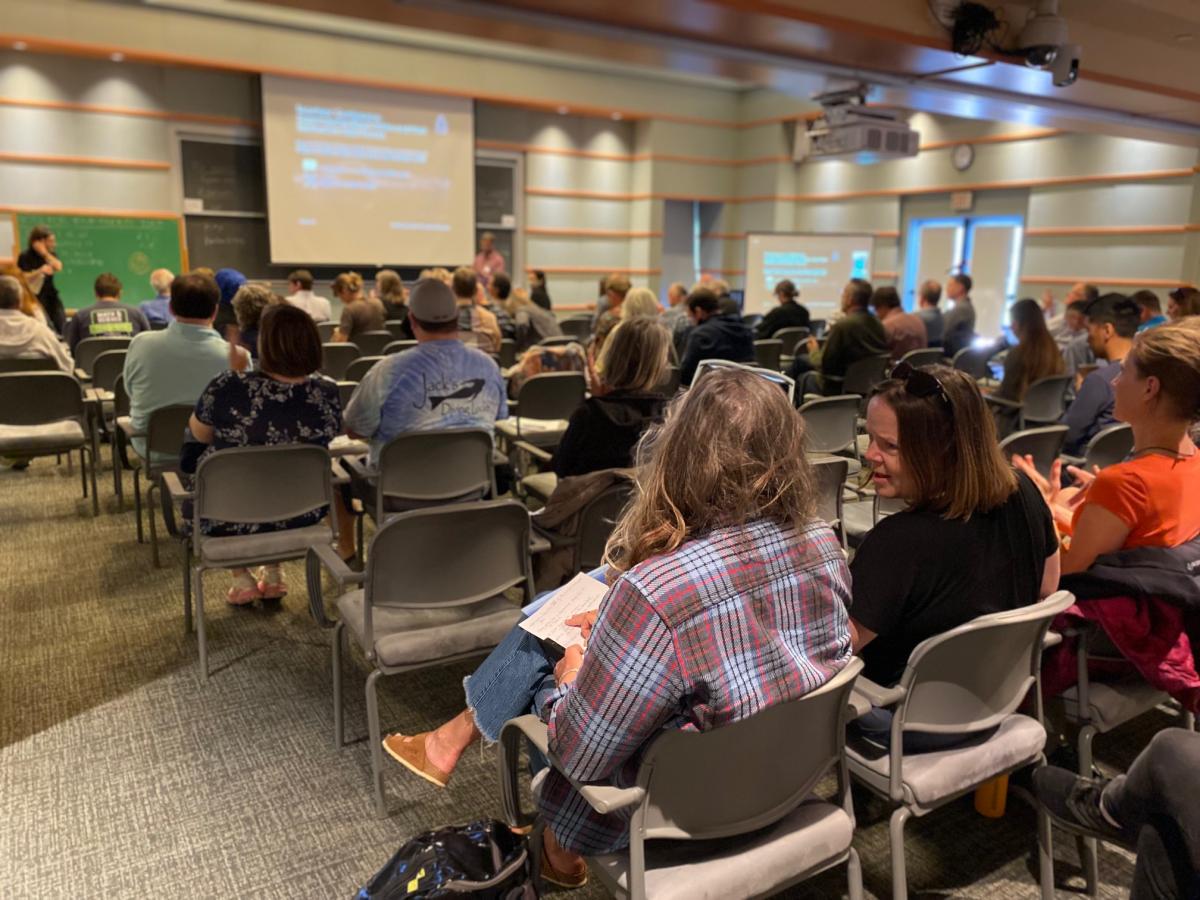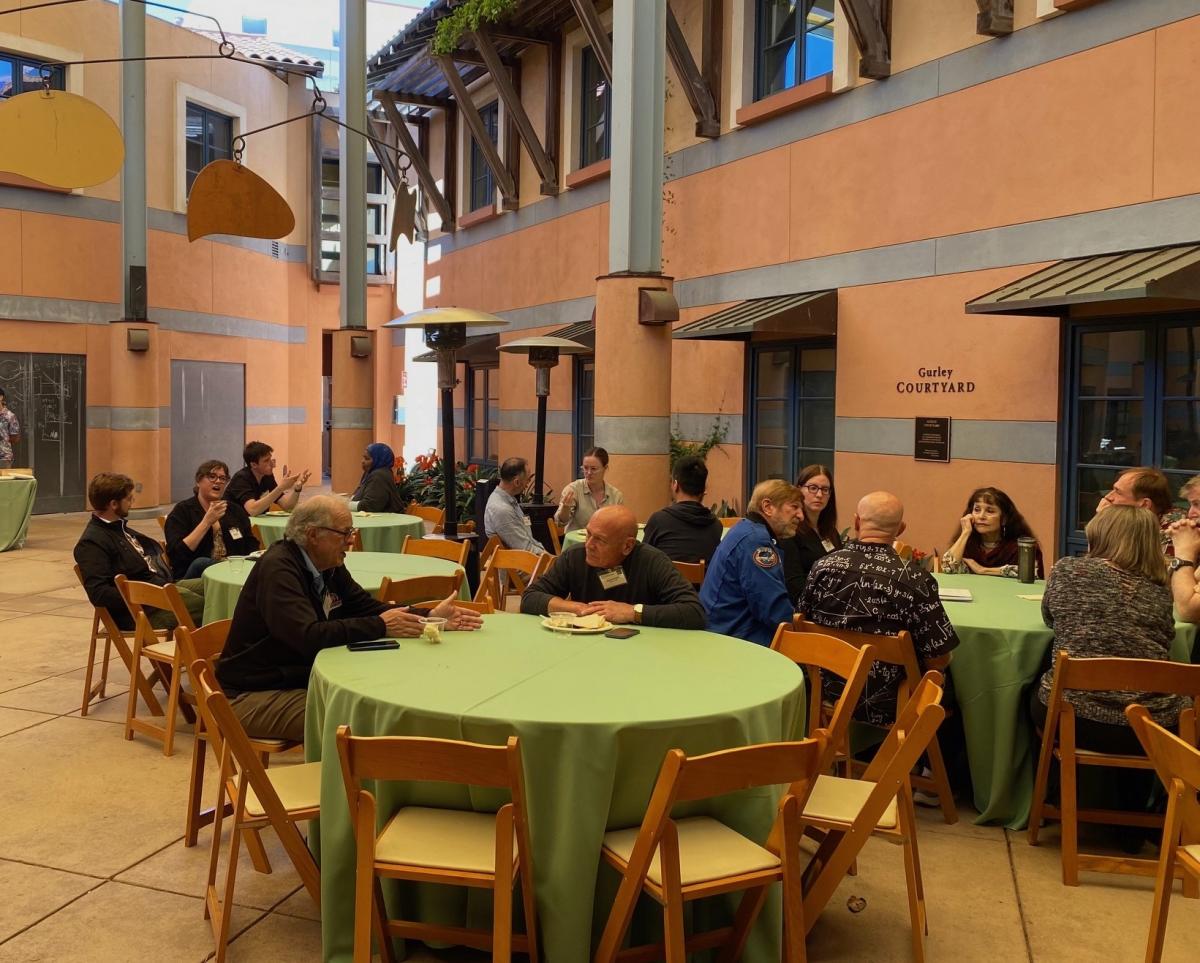When the teacher becomes the student for a day
 Image credit: Demi Cain
Image credit: Demi Cain
On April 27, 2024, KITP hosted the annual Teachers’ Conference for high school teachers and 2-year college instructors. This unique conference is one day jam-packed with discussions, classroom demonstrations, networking, and the opportunity for physics educators to learn about the latest developments in the field from leading researchers. This year, the conference was titled Supermassive Black Holes and their Destructive Tidal Forces.
The conference is coordinated by a visiting scientist who is also part of a concurrent KITP program on a similar topic. Assistant Professor Kate Alexander (University of Arizona) was this year’s leader. “I’ve always found doing outreach to be a lot of fun,” says Alexander, “and it’s actually part of the way I got interested in astronomy in the first place.” Her father was a member of an amateur astronomy club, so she fondly remembers attending events like star parties that grew her curiosity and passion. In her view, people who are not professional scientists often have some of the best questions and most interesting perspectives. Talking about science with people outside of the academic research community pushes her to think about her work in new ways, which is why she was happy to take on the role.
 Teachers' Conference participants engaging with KITP Postdocs and local physics faculty during the lunch break.
Teachers' Conference participants engaging with KITP Postdocs and local physics faculty during the lunch break.
Image credit: Demi Cain
Alexander selected speakers who research a variety of topics, and who have experience giving public talks or working with planetariums, schools, or other outreach initiatives. The first presentation was from Eric Coughlin, an Assistant Professor at Syracuse University who gave an overview of the physics involved in studying black holes. It was an energizing start to the day, and set the stage for Brenna Mockler, a postdoctoral fellow at Carnegie Observatories, to discuss tidal disruption events (TDEs) in greater depth.
TDEs occur when a star is ripped apart by the tidal gravity of a black hole. A portion of the star’s mass gets bound to the black hole, which essentially eats the mass through a process called accretion—Mockler compares it to the way marbles would orbit a wishing well and eventually fall into its center. When the mass accretes, it produces a flare of light that scientists can observe and use to study the properties of black holes.
Conference talks by Decker French (University of Illinois Urbana- Champaign) and Adelle Goodwin (Curtin University, Australia) discussed the kinds of data that emerge from these observations, how they are analyzed, and what they teach us about TDEs and black holes. French’s work concerns the visible light that results from accretion, while Goodwin studies radio emissions that come from materials moving away from a black hole instead of being consumed.
Most of the conference talks also demonstrate teaching tools or activities participants can take back to their students. Professor Kausik Das from University of Maryland Eastern Shore gave a mid-day demonstration with an online platform that prompted the audience to use their phones to answer questions about common misconceptions in physics. While a room full of students on their phones is a nightmare to most teachers, Das encouraged participants to use technology in the classroom to their advantage by exploring new ways for students to interact with material.
 Teachers using their phones for an activity led by Prof. Kausik Das.
Teachers using their phones for an activity led by Prof. Kausik Das.
Image credit: Demi Cain
Many educators at the conference are recurring visitors who have attended for multiple years. Maajida Murdock is a high school teacher and adjunct physics lecturer in Baltimore, Maryland who has attended so many times that she’s lost count! Murdock’s passion for science and education is evident. She has dedicated much of her career to advocating for STEM education that reaches all youth in her community, and she has been extensively involved in efforts to provide after-school and summer STEM programming to youth throughout Maryland.
One of the biggest obstacles Murdock has faced during her time teaching is making physics relevant to her students. She emphasizes that students at any age or educational level must be able to apply what they learn to the world around them. Murdock encourages students to “think about physics not as physics, but simply as the laws of nature. Who can’t relate to nature?” However, teachers are expected to follow a predefined curriculum which can add to the challenge. Alexander remembers learning about physics from outdated textbooks in high school that didn’t teach her about the latest research or modern methods scientists were using. She appreciates the impact the conference can have by providing teachers with up-to-date knowledge and resources to engage their students more effectively. Educators like Murdock continue to attend the Teacher’s Conference to learn about the new frontiers in physics and, most importantly, to learn how to empower their students and demystify the process of scientific inquiry.
by Demi Cain, KITP Development Coordinator
